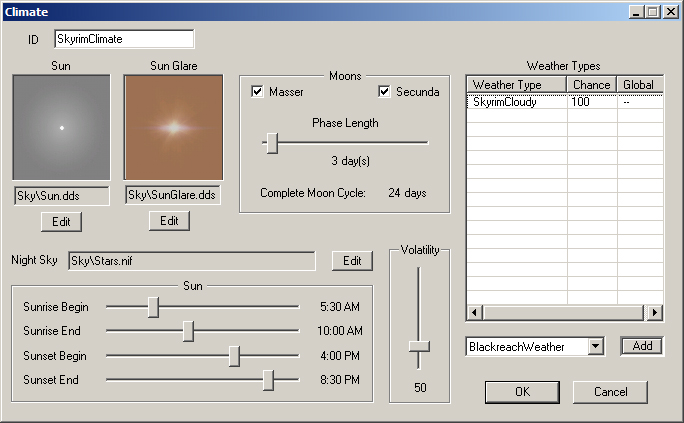Climate
| Language: | English • русский |
|---|
Climate Object[edit | edit source]
All climates defined for the loaded master file and plug-in are listed in the Object Window.
To create a new climate, right-click in the list of climates in the Object Window and select "new" from the popup. To create a new climate based off an existing climate, right-click the climate you wish to use as a basis and select "duplicate". To delete an existing climate, right-click that climate and select delete.
Climate Dialog[edit | edit source]
The Climate dialog can be opened by double-clicking an existing Climate in the Object Window in the tree under WorldData or by right-clicking an existing Climate and selecting "new".
The climate dialog allows you to define what types of weather a defined worldspace will experience, as well as the behavior of sky objects such as the sun, moons, and stars. An example (SkyrimClimate) is shown below:

Sun / Sun Glare[edit | edit source]
Choose a texture for the sun disc and sun glare. A preview of the selected texture will appear in the window above the selection button. Only valid textures with .dds extension can be selected. If no texture is defined for the sun disc, no sun will appear.
Moons[edit | edit source]
The phase length slider determines the length, in days, of each moon phase. There are 8 phases in the game so whatever number you choose, multiply it by 8 to determine the length, in days, of a full cycle.
Masser and Secunda always rises from the northeast and set in the southeast. Masser has a fixed time that it rises and sets. Always rising at around 8PM and setting a little after 4AM. Secunda however appears to have irregular moonrise and moonset times but it is actually orbiting around Masser. Secunda will rise 4hrs earlier than the last day over the course of 5 days, until it is 20 hours behind Masser. On the final day, Masser and Secunda will rise in conjunction. This means Secunda will appear twice in the same day.
The lunar phases in Skyrim: New Moon, Waning Crescent, Last Quarter, Waning Gibbous, Full Moon, Waxing Gibbous, First Quarter, Waxing Crescent.
By default, phases are 3 days long. It is a Full moon on the first day of its phase when the game starts(Sundas, 17th, Last Seed), and a New moon on the last day of its phase on the last day of Last Seed 4E 201.
Masser travels at an orbital speed of 0.25 units per second, over a distance of 7,200 units, while Secunda travels at an orbital speed of 0.30 units per second over a distance of 8,640 units. The orbital speed values are from the Game Settings, fMasserSpeed and fSecundaSpeed.
Clarifying the moonrise/set times using Masser as an example: Masser always begins to fade into view between 7:30-7:40 PM and begins to fade out of view alittle after 4:00 AM
Weather Types[edit | edit source]
Here is where you define what type of weather will be experienced using this climate. A list box of weather types and associated chances here defines which weather types are used and what the odds are that, when the system looks to change the weather, it will select that weather type.
To add a new weather type, select the weather type from the pull-down menu below the list box and click on the add button. To remove an existing weather type from the list, right-click on the row in the list box containing the weather you wish to remove and select "delete" from the popup menu. To change the chance for a given weather type, first select the weather by clicking on the row in the list box. Then, single-click again on that row and type in the number representing the percent chance for this weather. The numbers you choose should add up to 100, but if they don't, the system will simply calculate the odds based on the sum of all the chances.
Night Sky[edit | edit source]
Choose a valid NIF to be displayed as the night sky. This NIF will begin to alpha in during sunset, reaching full alpha after sunset is complete. It will begin to alpha out during sunrise, reaching a fully culled state after sunrise is complete.
Sun[edit | edit source]
Use sliders to determine when sunrise begins and ends, and when sunset begins and ends.
Volatility[edit | edit source]
Use volatility slider to determine how often the weather should change in a worldspace using this climate. A higher volatility means the weather will potentially change more often while a lower volatility will result in more static weather conditions.